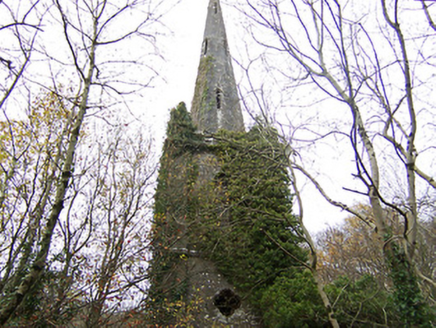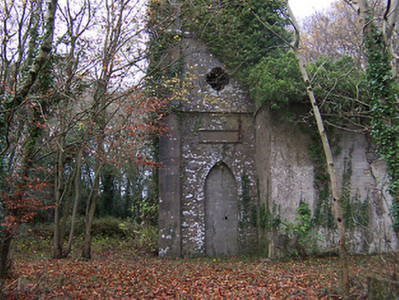Survey Data
Reg No
15401308
Rating
Regional
Categories of Special Interest
Architectural, Artistic, Social
Original Use
Church/chapel
Date
1795 - 1800
Coordinates
254570, 258552
Date Recorded
23/11/2004
Date Updated
--/--/--
Description
Freestanding Church of Ireland church, dated 1798, comprising three-bay hall with attached three-stage tower on square-plan to the west with raised parapet with Irish-style crenellations with corner pinnacles having spire on octagonal plan. Apsidal chancel to northeast, built of rubble limestone. Now derelict, out of use and overgrown with ivy. Pitched slate roof with raised limestone verges, now missing. Roughcast rendered walls to nave with ashlar limestone detailing, rubble limestone construction to tower with ashlar limestone detailing including corner buttresses and string courses. Pointed-arched openings to southeast side of nave (now blocked), blank to northwest side. Pointed-arched doorcase to southeast face of tower with date plaque over and a quatrefoil opening above to second stage of tower. Pointed-arched openings to belfry with remains of timber louvered vents. Set back from road in mature, overgrown grounds with collection of mostly nineteenth century grave markers. A beehive-shaped mausoleum (15401309) is found to the southeast of the church.
Appraisal
A fine Church of Ireland church, which retains its early form and character despite its dilapidated condition. It is nicely decorated with some good quality ashlar limestone detailing and has a very attractive and delicate tower and spire to the west end. Its layout is typical of the standard hall and tower church, which were built in great numbers, particularly between 1808-1830, using loans and grants from the Board of First Fruits (1722-1833). These small, simple, but well-built churches have become almost iconographic features of the rural Irish countryside. This church at Reynella was built at a cost of £831, of which £461 was a gift and the remainder a loan, from the Board of First Fruits in 1798. This church is surrounded by a graveyard with some fine nineteenth century grave markers of artistic merit. The unusual beehive-shaped mausoleum (15401309) to the south of the church was built c.1825 by Adolophus Cooke of Cooksborough House, a noted and colourful local eccentric, to house the remains of his father.



